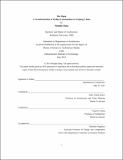| dc.contributor.advisor | Adèle Naudé Santos and Yung Ho Chang. | en_US |
| dc.contributor.author | Jiang, Menglin, S.M. Massachusetts Institute of Technology | en_US |
| dc.contributor.other | Massachusetts Institute of Technology. Department of Architecture. | en_US |
| dc.coverage.spatial | a-cc--- | en_US |
| dc.date.accessioned | 2013-10-24T18:12:26Z | |
| dc.date.available | 2013-10-24T18:12:26Z | |
| dc.date.copyright | 2013 | en_US |
| dc.date.issued | 2013 | en_US |
| dc.identifier.uri | http://hdl.handle.net/1721.1/81747 | |
| dc.description | Thesis (S.M.)--Massachusetts Institute of Technology, Dept. of Architecture, 2013. | en_US |
| dc.description | This electronic version was submitted by the student author. The certified thesis is available in the Institute Archives and Special Collections. | en_US |
| dc.description | Cataloged from student-submitted PDF version of thesis. | en_US |
| dc.description | Includes bibliographical references (p. 96-97). | en_US |
| dc.description.abstract | The walled communities, emerged as a result of rapid urbanization in the 80s, presents a unique typological settlement in the urban areas of Nanjing, China. These walled communities not only enclosed the housing clusters to provide sense of privacy, but also close off valuable city features adjacent to the walls of the communities and prevent the public from accessing these city features, such as water system, ancient city wall, and mountain. Therefore, making these resources within the walled communities open to the public should be highly prioritized during the process of the old town's renewal and renovation. However, to keep the privacy of the housing within the community presents a challenge in the process of making the resources available to the public and hence the main issue to tackle in this thesis. This thesis contains three parts. The first part defines the main issue and proposes the basic strategies as solutions. Through case study and drawing analysis, the second part defines the theoretical framework for the design issues and outlines the spatial composition and section design as the organizational solutions to open up the closeness of walled communities. The third part identifies appropriate walled communities in the old town area as sites to test out the new design strategies. The overall objective of this thesis is to open up the walled communities and return the once-enclosed resources to the public in hope to make the city features better connected to the urban space while maintaining the privacy for the housing itself. | en_US |
| dc.description.statementofresponsibility | by Menglin Jiang. | en_US |
| dc.format.extent | 97 p. | en_US |
| dc.language.iso | eng | en_US |
| dc.publisher | Massachusetts Institute of Technology | en_US |
| dc.rights | M.I.T. theses are protected by
copyright. They may be viewed from this source for any purpose, but
reproduction or distribution in any format is prohibited without written
permission. See provided URL for inquiries about permission. | en_US |
| dc.rights.uri | http://dspace.mit.edu/handle/1721.1/7582 | en_US |
| dc.subject | Architecture. | en_US |
| dc.title | Site open : a transformation of walled communities in Nanjing, China | en_US |
| dc.title.alternative | Walled communities in Nanjing, China | en_US |
| dc.type | Thesis | en_US |
| dc.description.degree | S.M. | en_US |
| dc.contributor.department | Massachusetts Institute of Technology. Department of Architecture | |
| dc.identifier.oclc | 859811496 | en_US |

